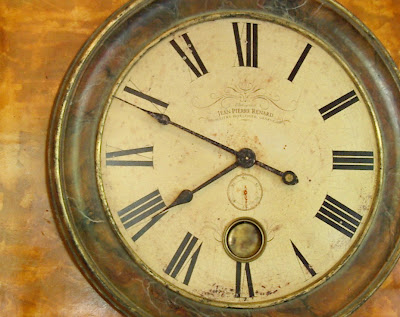These are hands down my new favorite dresses to make. You start with an unwanted dress shirt and turn it into something gorgeous. Here's a tutorial that will take you from this:
To this:
I started off with an XL short sleeved collared shirt. Any men's shirt with a collar will do. Larger sizes will give you more fabric to work with.
Using a seam ripper, carefully remove the front pocket(s). The fabric will self heal - any tiny holes from the stitching will disappear with a washing or two.
Try the shirt on your daughter and determine how much you'll need to take up the shoulders in order for the second button opening to not be too low. For my 4 1/2-year-old I took up the top 1 1/2" of the front and back shoulder, or 3" total. Also, place a pin on the shirt to mark the bottom of your daughter's knee, then add 2" for a hem.
To create the pattern, I tried a dress on her and pinned in the sides so it was slightly roomy in the chest and had a very gradual flare. The pattern should be as if you were making a sleeveless dress. You could also create a paper pattern based on a dress that seems the right fit.
Lay out the men's shirt with the shoulder seam slightly forward (as it would be if it were being worn). Place your pattern on top so that it is exactly centered over the buttons and is lower than the shoulder seams the amount that you will take up the shoulders (1 1/2" for my project).
Cut through both layers of the shirt adding an extra 5/8" to the pattern for seam allowance and length for the hem. Leave the shoulder seam and collar untouched. Remove the pattern and fold the shirt exactly in half along the buttons. Make sure the shoulder seams are even - you may want to pin them together to make sure they stay that way. Cut through both layers on the other half of the shirt using the side you already cut as a pattern. This will ensure symmetry.

Remove the sleeves from the remainder of the shirt. Lay them under the shirt so that they appear like this, making sure the shoulders of the shirt and sleeve are even. Using chalk or a fabric marker, trace along the line of the armhole and then parallel to the top of the sleeve. Then cut out the sleeve adding a 5/8" seam allowance to the armhole but not to the bottom of the sleeve. Use this sleeve as a pattern to cut out the other sleeve. If you are using a long-sleeved shirt, the process is the same, you'll just have to hem the bottom of the sleeve yourself.
Pin the sleeves to armhole of the dress, wrong sides together. Sew the sleeves to the dress and press seam. Next, pin the bottom of the sleeve and side seam, making sure to carefully match the stitch lines and armhole seams and pinning in place, again with wrong sides together. Stitch together.
Next, take up the shoulders. I did this by making what looks like the underside of a box pleat. The pleat measured 1 1/2" across, so including the underside, I took up 3". Sew a button, centered horizontally and vertically, on the box pleat. Make sure that in doing so you catch both sides of the underside of the pleat.
Measure from the button, around the sleeve, and to inside of the sleeve seam, pulling so that it slightly scrunches the sleeve. Then add 1/2". My measurement was 6". Cut two strips this length from the shirt's button placket. (I'll take finished seams whenever I can get them!) Make a buttonhole on one end that will fit the buttons used on the shoulder.
Pin these to the inside of the shoulder seam. Stitch in the ditch of the shoulder seam. Button the strips to the buttons on the shoulder seams.
Cut five pieces of fabric that are 1 1/4" x 2 1/4". These will be the belt loops. Iron each in half, then fold in the raw edges. Stitch to secure. Next, turn under the ends of the belt loop and iron. Have your daughter try the dress on and place pins just above her waistline at the locations where you will attach the belt loops (2 in front, two on the side seams, and one in the center back). Sew the belt loops onto the dress using a buttonhole stitch along both ends.
Make the waist tie by cutting a strip of material 3 1/2" x 40". I didn't have one continuous strip that was 40", so I sewed two pieces together to create enough length. Fold the strip in half, lengthwise. Sew the long edge together to create a tube. Turn the tube right side out. Tuck in the ends and press. Stitch along one of the long sides of the tie and along each short end.
Iron the bottom of the dress up 1/2", then another 1 1/2". Make sure that the two sides are exactly even when the dress is buttoned. Stitch.
And there you have it! A gorgeous dress, perfect for summertime. Now if I can just figure out some way to convince my husband to relinquish some of the bolder-colored dress shirts in his closet. I have my eye on a bright green one...
































































